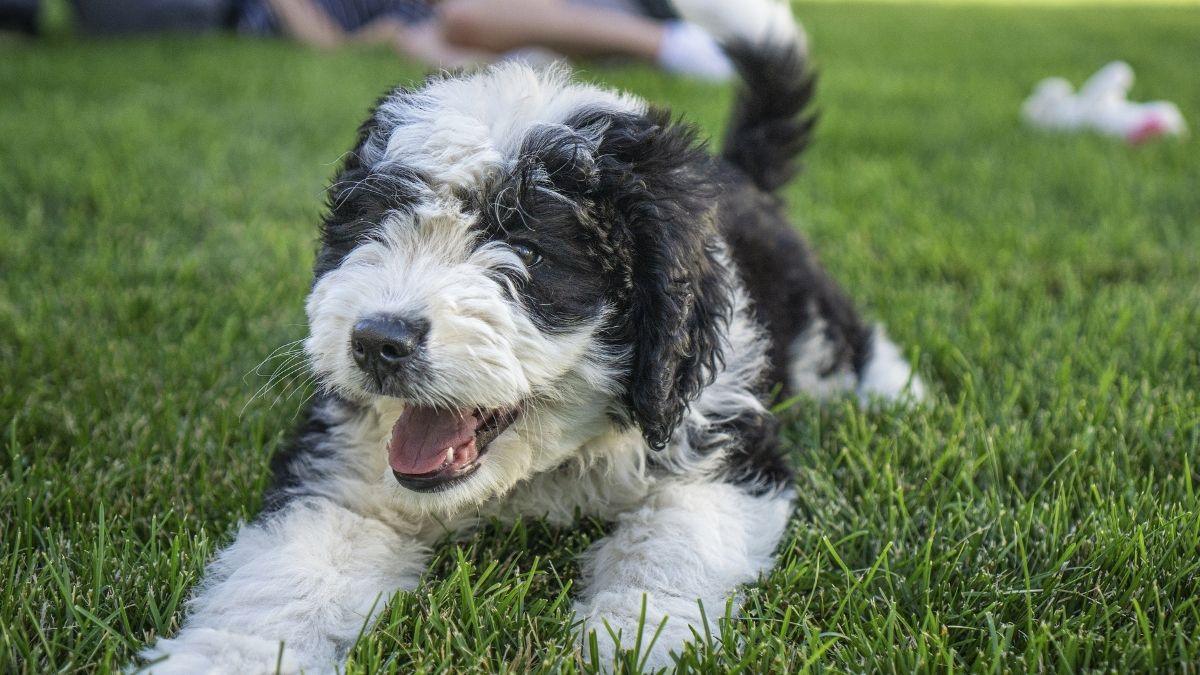Mini Bernedoodles have captured the hearts of many dog lovers with their charming demeanor and unique blend of characteristics inherited from their parent breeds, the Miniature Poodle and the Bernese Mountain Dog. One common query prospective owners often have revolves around the eventual size of these delightful companions. In this comprehensive guide, we will delve into the factors influencing the size of Mini Bernedoodles, their growth patterns, and tips for ensuring their healthy development.
What is a Mini Bernedoodle?

Mini Bernedoodle Origins
The Mini Bernedoodle is a crossbreed, or hybrid, resulting from the intentional mating of a Miniature Poodle and a Bernese Mountain Dog. This deliberate crossbreeding aims to combine the desirable traits of both parent breeds into one exceptional companion animal.
Characteristics
- Intelligence: Mini Bernedoodles inherit the intelligence of the Poodle parent, making them highly trainable and quick learners. This intelligence often translates into excellent obedience and problem-solving skills.
- Loyalty: From the Bernese Mountain Dog lineage, Mini Bernedoodles inherit a strong sense of loyalty and devotion to their human family members. They form deep bonds with their owners and are known for their unwavering loyalty.
- Hypoallergenic Qualities: One of the most sought-after traits of Mini Bernedoodles is their hypoallergenic coat. This means that they are less likely to trigger allergic reactions in individuals who are sensitive to pet dander, making them suitable companions for allergy sufferers.
- Affability: Mini Bernedoodles are typically friendly and sociable dogs. They enjoy the company of both humans and other pets, making them excellent family pets and companions for households with children or other animals.
- Adaptability: Due to their smaller size compared to standard Bernese Mountain Dogs, Mini Bernedoodles are often more adaptable to various living environments. They can thrive in apartments or smaller homes as well as larger living spaces, provided they receive adequate exercise and mental stimulation.
Purpose
The Mini Bernedoodle was intentionally bred to create a smaller-sized version of the Bernedoodle, catering to individuals who prefer a more compact dog with the same endearing qualities of the Bernese Mountain Dog. They excel as family pets, therapy dogs, and companions for individuals of all ages.
Popularity
Mini Bernedoodles have gained popularity in recent years due to their appealing combination of traits, including their intelligence, loyalty, hypoallergenic coat, and friendly disposition. Their smaller size makes them particularly attractive to urban dwellers or individuals with limited living space.
Variability
It’s important to note that, like all crossbreeds, Mini Bernedoodles can exhibit variability in temperament, appearance, and other traits. While breeders strive for consistency, each individual dog may inherit different proportions of characteristics from their Poodle and Bernese Mountain Dog parents.
Factors Influencing Size

Genetics
Genetics play a fundamental role in determining the size of Mini Bernedoodles. The genetic makeup inherited from their parent breeds, the Miniature Poodle and the Bernese Mountain Dog, influences various aspects of their physical characteristics, including size, height, and weight.
- Parental Size: The size of the Mini Bernedoodle’s parents is a significant determinant of its eventual size. If both parents are smaller in size, the offspring are likely to follow suit. Conversely, if one or both parents are larger, the resulting puppies may also be larger.
- Genetic Variability: While breeders strive to predict the size of Mini Bernedoodle offspring based on the sizes of the parents, genetic variability can lead to unexpected outcomes. Some puppies may inherit more traits from one parent breed than the other, resulting in variations in size within the same litter.
Nutrition
Nutrition plays a crucial role in the growth and development of Mini Bernedoodles. Providing a balanced diet that meets their nutritional needs is essential for ensuring optimal growth and achieving their full potential size.
- Balanced Diet: A diet rich in essential nutrients, including proteins, carbohydrates, fats, vitamins, and minerals, supports healthy growth and development. Adequate protein intake is particularly important for muscle development, while carbohydrates provide the energy necessary for an active lifestyle.
- Overfeeding: While proper nutrition is vital, overfeeding can lead to excessive weight gain, which may affect the dog’s growth trajectory. It’s essential to follow feeding guidelines and monitor portion sizes to prevent obesity, which can have adverse effects on overall health and development.
Exercise
Regular exercise is essential for the physical and mental well-being of Mini Bernedoodles. While exercise contributes to muscle development and overall fitness, it also influences their size and weight.
- Physical Activity: Engaging in regular physical activity helps maintain a healthy weight and promotes proper muscle development. Activities such as walking, running, playing fetch, and agility training are beneficial for Mini Bernedoodles.
- Avoid Over-Exercise: While exercise is important, it’s crucial to avoid over-exercising puppies, especially during periods of rapid growth. Over-exertion can put strain on developing bones and joints, potentially affecting their long-term health and size.
Growth Patterns

Understanding the growth patterns of Mini Bernedoodles is essential for owners to monitor their development and ensure they reach their full potential size while maintaining optimal health.
Size Range
Mini Bernedoodles typically fall within a specific range of height and weight as they mature. While there can be variations based on factors such as genetics and diet, owners can expect their Mini Bernedoodle to reach certain size parameters.
- Height: Mini Bernedoodles typically range from 18 to 22 inches in height at the shoulder when fully grown. This height range allows them to maintain a compact yet sturdy build suitable for various living environments.
- Weight: The weight of Mini Bernedoodles can vary between 25 to 50 pounds when fully grown. This weight range reflects the diversity within the breed and accommodates differences in size based on factors such as genetics and individual growth rates.
Growth Chart
A growth chart provides a useful reference for tracking the development of Mini Bernedoodles at different stages of their growth. While individual puppies may vary slightly, the following growth chart offers a general guideline for what owners can expect in terms of weight and length as their Mini Bernedoodle matures:
- Newborn (0–1 month): Puppies typically weigh 1–2 pounds and measure 3–4 inches in length.
- 2 months: At around 2 months of age, Mini Bernedoodles usually weigh between 6–8 pounds and measure 6–8 inches in length.
- 4 months: By 4 months, Mini Bernedoodles typically weigh between 12–16 pounds and measure 9–12 inches in length.
- 6 months: At 6 months of age, Mini Bernedoodles typically weigh between 18–22 pounds and measure 12–15 inches in length.
- 8 months: By 8 months, Mini Bernedoodles usually weigh between 23–30 pounds and measure 14–17 inches in length.
- 12 months: At around 12 months of age, Mini Bernedoodles typically weigh between 25–40 pounds and measure 16–20 inches in length.
- 14 months: By 14 months, Mini Bernedoodles typically reach their full height, weighing between 25–50 pounds and measuring 18–22 inches in length.
Growth Completion
While Mini Bernedoodles may continue to fill out slightly beyond their first year, their height growth typically stabilizes around 11 to 12 months of age. After reaching their maximum height, they may continue to gain muscle mass and fill out slightly until they are approximately 14 to 16 months old. However, individual growth rates may vary, and factors such as genetics, diet, and overall health can influence the timing and extent of growth completion.
Ensuring Healthy Development

Ensuring the healthy development of Mini Bernedoodles involves providing proper care, nutrition, and monitoring throughout their growth stages. By following essential guidelines, owners can support their Mini Bernedoodle’s physical and mental well-being, promoting optimal growth and overall health.
Ideal Diet
A balanced diet is crucial for Mini Bernedoodles to support their growth and development adequately. Here’s what an ideal diet should include:
- Proteins: High-quality animal proteins, such as chicken, beef, fish, and lamb, are essential for muscle development and repair.
- Carbohydrates: Complex carbohydrates, including sweet potatoes, brown rice, and oats, provide sustained energy for an active lifestyle.
- Fats: Beneficial fats, such as omega-3 and omega-6 fatty acids, support brain development and maintain a healthy coat and skin.
- Fiber, Vitamins, and Minerals: These nutrients are essential for maintaining digestive health, supporting the immune system, and overall well-being.
Measurement and Monitoring
Regularly measuring and monitoring your Mini Bernedoodle’s height and weight is essential for tracking their growth and ensuring they are developing appropriately. Here’s how to do it:
- Height: Measure from the ground to the highest point of the shoulders (the withers) while your dog is standing on a flat surface.
- Weight: Use a pet or veterinary scale to weigh your Mini Bernedoodle regularly. Ensure your dog is calm and still for an accurate reading.
Veterinary Consultations
Regular veterinary check-ups are crucial for monitoring your Mini Bernedoodle’s growth and overall health. Your veterinarian can provide valuable guidance on nutrition, exercise, and any specific health concerns related to your dog’s breed and size.
Exercise

Regular and appropriate exercise is essential for your Mini Bernedoodle’s healthy development. Here are some guidelines to follow:
- Physical Activity: Engage your Mini Bernedoodle in regular exercise to promote cardiovascular health, muscle development, and mental stimulation.
- Avoid Over-Exercise: While exercise is essential, avoid over-exercising puppies, as their bones and joints are still developing. Gradually increase the intensity and duration of exercise as your dog matures.
Conclusion
Understanding the growth patterns and factors influencing the size of Mini Bernedoodles is crucial for prospective and current owners alike. By providing a balanced diet, appropriate exercise, and regular monitoring, owners can ensure the healthy development of their beloved companions. As these charming dogs grow into adulthood, they continue to bring joy and companionship to their families, embodying the best qualities of both the Miniature Poodle and the Bernese Mountain Dog.
Through this guide, prospective and current owners can gain valuable insights into the growth patterns and factors influencing the size of Mini Bernedoodles. By providing a balanced diet, appropriate exercise, and regular monitoring, owners can ensure the healthy development of their beloved companions. As these charming dogs grow into adulthood, they continue to bring joy and companionship to their families, embodying the best qualities of both the Miniature Poodle and the Bernese Mountain Dog.

